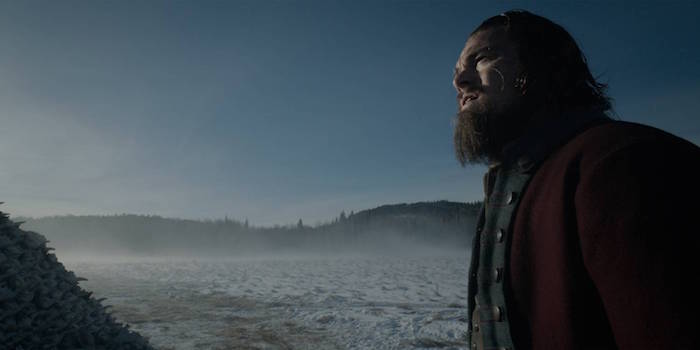There is a Mexican saying: “If the river sounds, it’s because it has water.” One can almost imagine Mexico City-born Alejandro Gonzalez Inarritu, who crossed an ocean on a cargo ship as a teenager, reflecting on this proverb throughout the making of his latest film.
The Revenant, for which Inarritu won a Golden Globe Award as Best Director on January 10, is linked from start to finish by water, by lakes, rivers, and streams, the sounds of which—in tandem with composer Ryuichi Sakamoto’s firm, leading chords—help lend the film its sombre, squeamish discomfort.
It begins along a river (shot in Alberta) and ends at one (in Argentina), and in between the roaring rapids and aching ice cry out alongside Leonardo DiCaprio, who would later describe the production as a “living hell.”
This is, after all, a survival story, and even the accompanying motifs—retribution, animal instinct, the justice of the land—are intensified by the current that runs through it.
Overall, Emmanuel Lubezki’s cinematography is astonishing in its scope and severity. He insisted on using only natural light, and his stubbornness, combined with Inarritu’s aversion to computer-generated imagery and requirement that shooting be done chronologically, saw the cast and crew pitted against an impossibility mirroring that of DiCaprio’s character, Hugh Glass.
It is Glass, who is tasked with guiding a fur-trading party through the wilderness of Montana and South Dakota, around whom the plot unfolds, and rivers run.
Left for dead after being attacked by a bear, and compelled by vengeance following the murder of his son, he finds the waters of the Louisiana Purchase to be at once his foe and his ally as he battles a broken body, the elements, and hostile tribesmen in a country as unforgiving as it is magnificent.
For long stretches of the film there isn’t a word spoken—the only sounds emitted by the panting, slithering Glass, his legs broken and sinews soaked by rivers and a light snow that covers the ground throughout. (It’s also worth noting, as an interesting parallel, the ease with which the Pawnee traverse their native land.)
Should DiCaprio win a much-anticipated Oscar for his performance, the penetrating moisture that so contributed to his physical disquiet will have as much to do with the accolade as anything else. There was nothing contrived in his agony; there was little acting required.
That, and the unease the audience shares with Glass until the credits, is down to the very intentional, uncomfortable roughness imparted on the process by Inarritu and Lubezki. The latter goes so far as to show half-melted, frothing rivers as scene dividers, and on the few occasions an evening fire is lit one becomes desperate to partake in the crackling, drying warmth alongside.
What The Revenant achieves is that rare, elusive aim of filmmaking: the shared experience. And in this instance it’s a primal one, rustic and wet.
This film is awash with themes and devices, but it is rivers that connect one to the next.
***
Jerrad Peters is a Winnipeg writer and Creative Content Specialist at Providence University College.
